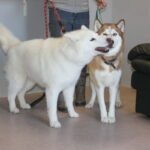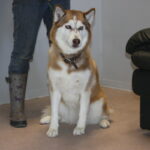Dog Grooming Services Husky

Call now and book your appointment to have your Husky groomed professionally 520-883-8464
Or text 520-419-0189
Grooming Price Siberian Husky: Starting at $: 75.00
All grooming service pricing always includes the nail trim and ear clean
Your dog will be groomed to your specs!
Siberian Husky
Breeders and judges have the responsibility to avoid any conditions or exaggerations that are detrimental to the health, welfare, essence and soundness of this breed, and must take the responsibility to see that these are not perpetuated.Any departure from the following should be considered a fault, and the seriousness with which the fault should be regarded should be in exact proportion to its degree and its effect upon the health and welfare of the dog and on the dog’s ability to perform its traditional work.
HISTORY
The Chukchi Indians, natives to the Soviet Arctic, developed the Siberian “Chukchi” (later changed to “Husky”), approximately 3,000 years ago. They needed a small sledding dog to haul small loads long distances. The dogs, brought by the Indians, eventually made their way across the Bering Straits to Alaska, and then to Canada and the United States. As a result of their use and close proximity to people, Siberian Huskies are known for their speed, endurance and good temperament.
The Siberian Husky was recognized by the United Kennel Club as the “Arctic Husky” in 1938. The breed name was changed to Siberian Husky in March of 1991.
GENERAL APPEARANCE
The Siberian Husky is a medium-sized, well-balanced working dog, with moderate bone, ease and freedom of movement and a good disposition. Their moderately compact, well-furred body, erect ears and brush tail indicate the breed’s Northern heritage.
The working characteristics of the breed have been maintained, ensuring that it is able to pull a light load, in harness, at a moderate speed over great distances. The basic balance of power, speed and endurance is reflected in his proportions and form. A dog in proper condition, with firm, well-developed muscles, does not carry excess weight. They never appear so heavy as to suggest a freighting animal nor so light as to suggest a sprint-racing animal. Males are masculine, but never coarse. Females are feminine, but not weak.
In addition to the noted faults, any obvious structural faults common to all breeds are as undesirable in the Siberian Husky as in any other breed.
CHARACTERISTICS
The Siberian Husky is characteristically friendly and gentle, while also being alert and outgoing. The mature dog may display some measure of reserve and dignity. The breed is not possessive, overly suspicious of strangers, nor aggressive with other dogs. Their intelligence, tractability and eager disposition make them agreeable companions and willing workers.
HEAD
The medium-size head is in proportion to the size of the body.
SKULL
The skull is slightly rounded on the top, and tapers gradually from the widest point to the eyes. The stop is well defined.
MUZZLE
The distance from the stop to the tip of the nose is equal to the distance from the occiput to the stop. The muzzle is of medium length and width, tapering gradually to the nose. The bridge of the nose, from the stop to the tip, is straight. The tip of the nose is neither pointed nor square. The close fitting lips are well pigmented.
Faults: Clumsy or heavy head. Head too finely chiseled. Muzzle too snipey, too coarse, too short or too long. Insufficient stop.
TEETH
A full complement of strong, white teeth meet in a scissors bite.
Faults: Any bite other than scissors.
EYES
The almond-shaped eyes are moderately spaced and set a trifle obliquely. Their keen, but friendly, expression shows interest and even mischievousness. Eye color may be brown or blue; one eye of each color and parti-colored eyes are acceptable.
Faults: Set too obliquely. Set too close together.
NOSE
Various colored noses are acceptable. They may be black in black, gray or tan dogs; liver-colored in copper dogs; and flesh colored in pure white dogs. The snow nose, which is pink streaked, is also acceptable.
EARS
The medium-sized, triangular-shaped ears are close fitting and set high on the head. They are thick, well furred and slightly arched at the back. They are strongly erect, with the slightly rounded tips pointing straight up.
Faults: Too large in proportion to the size of the head. Too wide set. Not strongly erect.
NECK
The medium length, arched neck is carried proudly erect when the dog is standing. The neck is carried slightly forward when the dog is moving at a trot.
Faults: Too short and thick. Too long.
FOREQUARTERS
The well-laid-back shoulder blade is at an approximate angle of 45 degrees to the ground. The upper arm angles slightly backward from the point of the shoulder to the elbow, and is never perpendicular to the ground. The muscles and ligaments that hold the shoulder to the rib cage are firm and well developed.
Faults: Straight shoulders. Loose shoulders.
FORELEGS
The moderately spaced forelegs are parallel and straight when viewed from the front. Bone is substantial, but never heavy. The elbows are close to the body, turning neither in nor out. In profile, the pasterns are slightly slanted. The wrist is strong, but flexible.
The length of the leg, from the elbow to the ground, is slightly more than the distance measured from the top of the withers to the elbow. Dewclaws on the forelegs may be removed.
Faults: Weak pasterns. Bone too heavy. Too narrow or too wide in the front. Out at the elbows.
BODY
The topline is level. The medium length back is straight and strong. The taut, lean loin is narrower than the rib cage, with a slight tuck-up. The sloping croup is never so steep as to restrict the rearward thrust of the hind legs.
The deep, strong chest is not too broad. The deepest point is just behind and level with the elbows. The ribs are well sprung from the spine, and flatten on the sides to allow freedom of action.
The length of the body, measured from the point of the shoulder to the rear point of the croup, is slightly longer than the height, measured from the withers to the ground.
Faults: Weak or slack back. Roach back. Sloping topline. Chest too broad. Barrel ribs. Too flat or weak ribs.
HIND LEGS
The moderately spaced legs are parallel when viewed from the rear. The well-muscled upper thighs are powerful. The stifles are well bent. The well-defined hock is set low to the ground. Any dewclaws on the hind legs are removed.
Faults: Straight stifles. Cowhocks. Rear too wide or too narrow.
FEET
The oval-shaped feet are not too long. The compact, medium-size paws are well furred between the toes and the tough, thickly-cushioned pads. At a natural stance, the paws turn neither in nor out.
Faults: Soft or splayed toes. Too large and clumsy paws. Too small and delicate paws.
TAIL
The well-furred tail is of fox brush shape. It is set on just below the level of the topline, and is carried in a graceful sickle curve over the back when the dog is at attention. It is not curled to either side of the body. When the dog is in repose, the tail may trail.
The medium-length hair is approximately the same length on the top, sides, and bottom of the tail, giving the appearance of a round brush.
Faults: Snapped or tightly curled. Highly plumed. Set too low or too high.
COAT
The breed is double coated, the hair being medium length, giving a well-furred appearance. The outer coat guard hairs are straight and somewhat smooth lying. The soft, dense undercoat is of sufficient length to support the outer coat. The absence of an undercoat during shedding season is normal and not to be penalized. It is permissible to trim the whiskers and the fur between the toes, but the trimming of the fur on any other part of the dog is to be severely penalized.
Faults: Long, rough or shaggy coat. Too harsh or too silky in texture. Guard hairs standing straight off from the body. Hair so long as to obscure the clean-cut outline of the dog.
COLOR
All colors, from black to pure white, are allowed. A variety of markings on the head is common, including many striking patterns not found in other breeds.
HEIGHT & WEIGHT
Height is measured at the withers. Height ranges are as follows: Males, 21 inches up to, and including, 23½ inches; females, 20 inches up to, and including, 22 inches. Weight is to be in proportion to height. The following weight parameters (as well as the height parameters above) present the extreme limits. No preference is to be given to either extreme. Weight ranges are as follow: Males, 45 to 60 pounds; females, 35 to 50 pounds.
GAIT
The characteristic gait is smooth and seemingly effortless. They are quick and light on their feet. While gaiting, the topline remains firm and level. The good reach of the forequarters and the good drive of the hindquarters are best viewed at a moderately fast trot. As speed increases, the dog single tracks. The forelegs and hind legs are carried straight forward, with neither the elbows nor stifles turning in or out. Each hind leg moves in the path of its corresponding foreleg.
Faults: Short, prancing or choppy gait. Lumbering or rolling gait. Crossing. Crabbing.
ELIMINATING FAULTS
(An Eliminating Fault is a Fault serious enough that it eliminates the dog from obtaining any awards in a conformation event.)
Males over 23½ inches in height. Females over 22 inches in height.
DISQUALIFICATIONS
(A dog with a Disqualification must not be considered for placement in a conformation event, and must be reported to UKC.)
Unilateral or bilateral cryptorchid.
Viciousness or extreme shyness.
Albinism.






